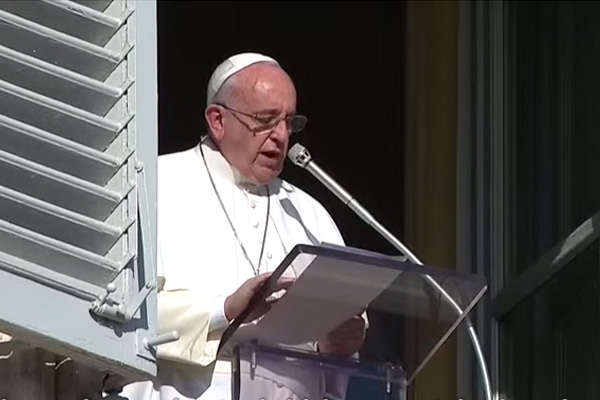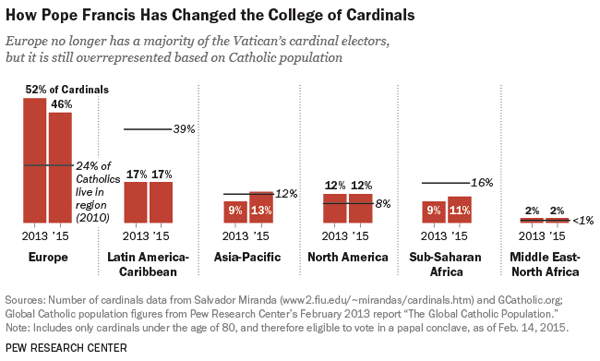
Pope Francis’ New Cardinals Encourage Diversity
- By Alison Lesley --
- 13 Jan 2015 --

Pope Francis’ newly appointed cardinals reflect the new direction of diversity that the Pope wants to lead the Catholic Church.
At the beginning of the month, Pope Francis appointed 20 new Cardinals in a fashion that is somewhat divergent from the traditional selection pattern as it is known in the Vatican.
Displaying and reiterating his resolve and commitment to transform the Vatican and the Church from the inside out, just as he did in his early 2014 selection, Francis handpicked the 20 Cardinals emphasizing leaders from poor and developing countries, clearly navigating away from the usual choices in North America and Europe.
Most of the bishops now called by Pope Francis to the College of Cardinals are from countries that are not wealthy – and have less to financially contribute to the Catholic Church – regions coping with political oppression, and areas where the Church is beginning to pick up in growth. These new cardinals are from nations like Myanmar, Ethiopia, Vietnam, and Mexico, a break from the more common European cardinals.
The Tonga Islands and the Cape Verde Islands, two nations that have never had a cardinal, now each have new leaders in the Catholic hierarchy. Just one of the new cardinals was selected from the Vatican bureaucracy and none are from the United States. This goes to show the efforts being made by the Pope to geographically diversify the hierarchy in Vatican City, as well as spread the Catholic mission across the globe.
In announcing the new Cardinals to the crowd gathered in St. Peter’s Square, the Pope claimed that his selection represents “every continent, to manifest the indissoluble links between the Church of Rome and the particular churches present in the world.”
“The most evident criteria is evidently that of universality,” Reverend Federico Lombardi, a Vatican spokesman, commented. “Fourteen different countries are represented, including some that do not currently have a cardinal, and some that have never had one,” he added.
“He’s emphasizing the notion that the church really is universal, it’s not just a reflection of Europe, or of economically strong countries, even those that most support the church financially,” according to Andrea Tornielli, coordinator of Vatican Insider.
Of the 20 cardinals selected, 15 carry the franchising power to elect a new pope, as they are less than 80 years old (a requirement in the Vatican to be able to take part in the election of a new Pontiff). These 15 also form the new pool of Cardinals that could possibly be elected to the prime position of Pope.
In addition to the fifteen under-80 Cardinals, five retired archbishops and bishops were called to the College of Cardinals as well. These veterans were appointed from countries like Colombia, Argentina and Mozambique.
They were named to the College of Cardinals because they were “distinguished for their pastoral charity in the service of the Holy See and of the church,” Pope Francis said. The self-styled, down-to-earth Pontiff has made a remarkable effort to change the image of the Catholic Church, but as it is with leadership in any other setting, can he do it alone?
The new group of Cardinals will be formally elevated on February 14, in a ceremony called a consistory, following a key meeting of the cardinals about reforms of the Vatican’s organization.
The following is a list of the 15 new cardinals as announced by the Vatican:
1 – Mons. Dominique Mamberti , Titular Archbishop of Sagona, Prefect of the Supreme Tribunal of the Apostolic Signatura.
2 – Mons. Manuel José Macário do Nascimento Clemente , Patriarch of Lisbon (Portugal).
3 – Mons. Berhaneyesus Demerew Souraphiel, CM, Archbishop of Addis Ababa (Ethiopia).
4 – Msgr. John Atcherley Dew , Archbishop of Wellington (New Zealand).
5 – Mons. Edoardo Menichelli , Archbishop of Ancona-Osimo (Italy).
6 – Mons. Pierre Nguyen Van Nhon , Archbishop of Hanoi (Vietnam).
7 – Msgr. Alberto Suárez Inda , Archbishop of Morelia (Mexico).
8 – Mons. Charles Maung Bo, SDB, Archbishop of Yangon (Myanmar).
9 – Msgr. Francis Xavier Kriengsak Kovithavanij , Archbishop of Bangkok (Thailand).
10 – Mons. Francesco Montenegro , Archbishop of Agrigento (Italy).
11 – Mons. Daniel Fernando Sturla Berhouet, SDB, Archbishop of Montevideo (Uruguay).
12 – Mons. Ricardo Blázquez Pérez , Archbishop of Valladolid (Spain).
13 – Mons. José Luis Lacunza Maestrojuan , OAR, Bishop David (Panama).
14 – Mons. Arlindo Gomes Furtado , Bishop of Santiago de Cabo Verde (Cape Verde Archipelago).
15 – Mons. Soane Patita Paini Mafi , Bishop of Tonga (Tonga Islands).
The following is a list of the older members appointed recognized for their pastoral charity:
1 – Mons. José de Jesús Rodríguez Pimiento , retired archbishop of Manizales.
2 – Mons. Luigi De Magistris , Titular Archbishop of Nova, Pro-Penitentiary Emeritus.
3 – Msgr. Karl-Josef Rauber , Titular Archbishop of Giubalziana, Apostolic Nuncio.
4 – Mons. Luis Héctor Villalba , Archbishop Emeritus of Tucumán.
5 – Mons. Julio Duarte Langa , Bishop Emeritus of Xai-Xai.
In less than two years, Pope Francis has started to tilt the geographical balance of the traditionally Europe-centric College of Cardinals to other parts of the world.



















